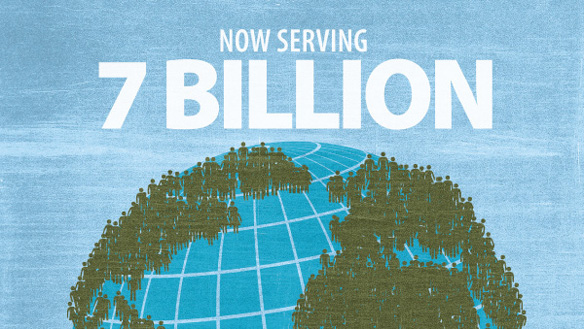Seven billion people now live on earth, only a dozen years after global population hit six billion. But the seven billion milestone is not about sheer numbers: Demographic trends will significantly impact the planet’s resources and peoples’ security.
Growing populations stress dwindling natural resource supplies while high levels of consumption in both developed countries and emerging economies drive up
carbon emissions and deplete the planet’s resources. And neglected “youth bulges” could bolster extremism in fragile states like
Somalia and destabilize nascent democracies like
Egypt.
Here are seven ways seven billion people affect the planet, according to recent research:
Security: Nearly 90 percent of countries with very young and youthful populations had undemocratic governments at the end of the 20th century. Eighty percent of all new civil conflicts between 1970 and 2007 occurred in countries where at least 60 percent of the population is under age 30, says demographer Elizabeth Leahy Madsen. According to research by demographer Richard Cincotta, these countries may achieve democracy, but are less likely to sustain it.
Climate: The impact of demographic trends on climate change is complex. Aging in industrialized nations could reduce carbon emissions in the long term, while urbanization in developing countries could increase emissions, according to research led by Brian O’Neill of the National Center for Atmospheric Research. Overall, slowing population growth by 2050 could meet 16-29 percent of the reductions in carbon emissions necessary to avoid climate change.
Water: By 2025, 1.8 billion people will be living in countries with water scarcity, and fully two-thirds will be living in conditions of water stress. People are using groundwater faster than it can be naturally replenished, putting us in danger of “peak water,” says MacArthur “Genius” Fellow Peter Gleick. “We cannot talk about water without also understanding the enormously important role of population dynamics and population growth.”
Food: Population growth has forced more than 20 water and/or cropland-scarce countries to import grain, making them vulnerable to food-price volatility in the international marketplace. To meet the demands of the future, we must double world food supplies by 2050, if not sooner, all while reducing our impact on the environment, according to Jon Foley of the University of Minnesota.
Forests: The growing demand for energy has helped devastate tropical forests, as more than two billion people depend on wood for cooking and heating, particularly in developing countries. Projects in Indonesia, Nepal, and Uganda are fighting deforestation by providing alternative energy and incomes along with health and family planning services.
Biodiversity: Population density is connected to the loss of biodiversity in many regions. Data from the Apache Highlands along the U.S.-Mexico border indicate that biodiversity tends to drop off at population densities of more than 10 people per square kilometer, according to research by Richard Gorenflo at Penn State University.
Future Growth: By 2050, the UN says global population could range anywhere from 8 billion to 11 billion – and where it ends up depends in large part on the status of women in developing countries. “Even if fertility rates remain constant at current levels (which is unlikely), developing regions would grow from 5.7 billion in 2010 to 9.7 billion in 2050, but the total population of developed countries would remain essentially unchanged,” writes Madsen.
Population growth is not just the planet’s problem. Women in developing countries with high fertility rates are more likely to suffer from poor health and low literacy. It is a vicious cycle: More children, inadequate healthcare, and less education make it harder for women to help their families adapt to scarce supplies of food, water, and energy.
There are no quick solutions to these seven problems. But meeting the unmet need for contraception of more than 200 million women is an effective and inexpensive way to start.
Sources: Population Action International, UN, World Health Organization.
Image Credit: Used with permission courtesy of Scott Woods, The University of Western Ontario.

 A Publication of the Stimson Center.
A Publication of the Stimson Center.



